Dynamic Evolution of Safety Regulation of the Ridesharing Industry under Social Media Participation
Abstract
:1. Introduction
2. Evolutionary Game Model under Social Media Participation
2.1. Model Description
2.2. Model Construction
2.2.1. Game Strategy
2.2.2. Payoff Matrix of Governments and Platform Companies
2.2.3. The Solution of Equilibrium Points
3. State Classification of Regulation under Social Media Participation
3.1. Evolution State
3.2. States Classification according to IP and PD
4. The Influence Analysis for Safety Regulation
4.1. Evolution State Influence Analysis at Different Scenarios
4.2. Simulation Experiment
4.3. Futher Discussion about State 3 and State 4
5. Conclusions
Author Contributions
Funding
Conflicts of Interest
References
- Wang, X.; Agatz, N.; Erera, A. Stable matching for dynamic ride-sharing systems. Transp. Sci. 2017, 52, 850–867. [Google Scholar] [CrossRef]
- Agatz, N.; Erera, A.; Savelsbergh, M.W.P.; Wang, X. Optimization for dynamic ride-sharing: A review. Eur. J. Oper. Res. 2012, 223, 295–303. [Google Scholar] [CrossRef]
- Rayle, L.; Dai, D.; Chan, N.; Cervero, R.; Shaheen, S. Just a better taxi? A survey-based comparison of taxis, transit, and ridesourcing services in San Francisco. Transp. Policy 2016, 45, 168–178. [Google Scholar] [CrossRef] [Green Version]
- Alonso-Mora, J.; Samaranayake, S.; Wallar, A.; Frazzoli, E.; Rus, D. On-demand high-capacity ride-sharing via dynamic trip-vehicle assignment. Proc. Natl. Acad. Sci. USA 2017, 114, 462–467. [Google Scholar] [CrossRef] [PubMed] [Green Version]
- Sun, Q.; He, Y.; Wang, Y.; Ma, F. Evolutionary Game between Government and Ride-Hailing Platform: Evidence from China. Discret. Dyn. Nat. Soc. 2019, 2019, 9545102. [Google Scholar] [CrossRef]
- Rogers, B. The Social Costs of Uber. Univ. Chic. Law Rev. 2015, 82, 85. [Google Scholar] [CrossRef] [Green Version]
- Feeney, M. Is Ridesharing Safe? Cato Institute Policy Analysis: Washington, DC, USA, 2015. [Google Scholar]
- Moody, J.; Middleton, S.; Zhao, J. Rider-to-rider discriminatory attitudes and ridesharing behavior. Transp. Res. Part F Traffic Psychol. Behav. 2019, 62, 258–273. [Google Scholar] [CrossRef]
- Chaudhry, B.; Yasar, A.; El-Amine, S.; Shakshuki, E. Passenger Safety in Ride-Sharing Services. Procedia Comput. Sci. 2018, 130, 1044–1050. [Google Scholar] [CrossRef]
- Dills, A.K.; Mulholland, S.E. Ride-Sharing, Fatal Crashes, and Crime. South. Econ. J. 2018, 84, 965–991. [Google Scholar] [CrossRef]
- Furuhata, M.; Dessouky, M.; Ordóñez, F.; Brunet, M.-E.; Wang, X.; Koenig, S. Ridesharing: The state-of-the-art and future directions. Transp. Res. Part B Methodol. 2013, 57, 28–46. [Google Scholar] [CrossRef]
- Berlingerio, M.; Ghaddar, B.; Guidotti, R.; Pascale, A.; Sassi, A. The GRAAL of carpooling: GReen and sociAL optimization from crowd-sourced data. Transp. Res. Part C Emerg. Technol. 2017, 80, 20–36. [Google Scholar] [CrossRef]
- Ranchordás, S. Does sharing mean caring: Regulating innovation in the sharing economy. Minn. J. Law Sci. Technol. 2015, 16, 413. [Google Scholar]
- Li, Y.; Taeihagh, A.; De Jong, M. The Governance of Risks in Ridesharing: A Revelatory Case from Singapore. Energies 2018, 11, 1277. [Google Scholar] [CrossRef] [Green Version]
- Paik, Y.; Kang, S.; Seamans, R. Entrepreneurship, innovation, and political competition: How the public sector helps the sharing economy create value. Strateg. Manag. J. 2019, 40, 503–532. [Google Scholar] [CrossRef]
- Posen, H.A. Ridesharing in the sharing economy: Should regulators impose Uber regulations on Uber. Iowa Law Rev. 2015, 101, 405. [Google Scholar]
- Li, Y.; Ma, L. What drives the governance of ridesharing? A fuzzy-set QCA of local regulations in China. Policy Sci. 2019, 52, 601–624. [Google Scholar] [CrossRef]
- Yuana, S.L.; Sengers, F.; Boon, W.; Raven, R. Framing the sharing economy: A media analysis of ridesharing platforms in Indonesia and the Philippines. J. Clean. Prod. 2019, 212, 1154–1165. [Google Scholar] [CrossRef] [Green Version]
- Cannon, B.; Chung, H. A framework for designing co-regulation models well-adapted to technology-facilitated sharing economies. Santa Clara Comput. High Technol. Law J. 2014, 31, 23. [Google Scholar]
- Finck, M. Digital Regulation: Designing a Supranational Legal Framework for the Platform Economy. LSE Law Stud. Econ. Work. Pap. 2017, 15, 2017. [Google Scholar] [CrossRef] [Green Version]
- Kapoor, K.; Tamilmani, K.; Rana, N.P.; Patil, P.; Dwivedi, Y.K.; Nerur, S. Advances in Social Media Research: Past, Present and Future. Inf. Syst. Front. 2017, 20, 531–558. [Google Scholar] [CrossRef] [Green Version]
- Aerts, W.; Cormier, D. Media legitimacy and corporate environmental communication. Account. Organ. Soc. 2009, 34, 1–27. [Google Scholar] [CrossRef]
- Martin, R.; Senni, C.; D’Cruze, N.C. Trade in wild-sourced African grey parrots: Insights via social media. Glob. Ecol. Conserv. 2018, 15, e00429. [Google Scholar] [CrossRef]
- Loukis, E.; Charalabidis, Y.; Androutsopoulou, A. Promoting open innovation in the public sector through social media monitoring. Gov. Inf. Q. 2017, 34, 99–109. [Google Scholar] [CrossRef]
- Robertson, J.; Walkom, E.; Bevan, M.D.; Newby, D.A. Medicines and the media: News reports of medicines recommended for government reimbursement in Australia. BMC Public Health 2013, 13, 489. [Google Scholar] [CrossRef] [PubMed] [Green Version]
- Baloria, V.P.; Heese, J. The effects of media slant on firm behavior. J. Financ. Econ. 2018, 129, 184–202. [Google Scholar] [CrossRef] [Green Version]
- Piotroski, J.D.; Wong, T.J.; Zhang, T. Political Incentives to Suppress Negative Information: Evidence from Chinese Listed Firms. J. Account. Res. 2015, 53, 405–459. [Google Scholar] [CrossRef] [Green Version]
- El Ghoul, S.; Guedhami, O.; Nash, R.; Patel, A. New evidence on the role of the media in corporate social responsibility. J. Bus. Ethics 2019, 154, 1051–1079. [Google Scholar] [CrossRef]
- Borochin, P.; Cu, W.H. Alternative corporate governance: Domestic media coverage of mergers and acquisitions in China. J. Bank. Financ. 2018, 87, 1–25. [Google Scholar] [CrossRef]
- Andorfer, A. Spreading like Wildfire: Solutions for Abating the Fake News Problem on Social Media via Technology Controls and Government Regulation. Hastings Law J. 2017, 69, 1409. [Google Scholar]
- Kashyap, P.; Koundinya, A. Secure dynamic carpooling android application using novel multi-agent approach for an organization. In Proceedings of the 2016 International Conference on Computation System and Information Technology for Sustainable Solutions (CSITSS), Bangalore, India, 6–8 October 2016. [Google Scholar]
- Ni, J.; Zhang, K.; Lin, X.; Yang, H.; Shen, X. AMA: Anonymous mutual authentication with traceability in carpooling systems. In Proceedings of the 2016 IEEE International Conference on Communications (ICC), Kuala Lumpur, Malaysia, 22–27 May 2016. [Google Scholar]
- Zhu, X.; Huang, I.Y.; Manning, L. The role of media reporting in food safety governance in China: A dairy case study. Food Control. 2019, 96, 165–179. [Google Scholar] [CrossRef]
- Li, Y.; Phau, I.; Lu, W.; Teah, M. Crisis management of food security scandals in China: Motivations and solutions towards purchase intention. J. Consum. Behav. 2017, 17, 13–24. [Google Scholar] [CrossRef]
- Gao, S.; Ling, S.; Liu, W. The Role of Social Media in Promoting Information Disclosure on Environmental Incidents: An Evolutionary Game Theory Perspective. Sustainability 2018, 10, 4372. [Google Scholar] [CrossRef] [Green Version]
- Dekel, E.; Fudenberg, E.; Levine, D.K. Learning to play Bayesian games. Games Econ. Behav. 2004, 46, 282–303. [Google Scholar] [CrossRef] [Green Version]
- Smith, J.M. Evolutionary game theory. Phys. D Nonlinear Phenom. 1986, 22, 43–49. [Google Scholar] [CrossRef]
- Gokhale, C.S.; Traulsen, A. Evolutionary Multiplayer Games. Dyn. Games Appl. 2014, 4, 468–488. [Google Scholar] [CrossRef] [Green Version]
- Yu, K.; Zhou, L.; Cao, Q.; Li, Z. Evolutionary Game Research on Symmetry of Workers’ Behavior in Coal Mine Enterprises. Symmetry 2019, 11, 156. [Google Scholar] [CrossRef] [Green Version]
- Szolnoki, A.; Mobilia, M.; Jiang, L.-L.; Szczesny, B.; Rucklidge, A.; Perc, M. Cyclic dominance in evolutionary games: A review. J. R. Soc. Interface 2014, 11, 20140735. [Google Scholar] [CrossRef] [Green Version]
- Lu, R.; Wang, X.; Yu, H.; Li, D. Multiparty Evolutionary Game Model in Coal Mine Safety Management and Its Application. Complexity 2018, 2018, 9620142. [Google Scholar] [CrossRef] [Green Version]
- Li, X.; Li, X.; Meng, X. Effectiveness research on the multi-player evolutionary game of coal-mine safety regulation in China based on system dynamics. Saf. Sci. 2018, 111, 224–233. [Google Scholar] [CrossRef]
- Yinghua, S.; Ningzhou, S.; Dan, L. Evolutionary game and intelligent simulation of food safety information disclosure oriented to traceability system. J. Intell. Fuzzy Syst. 2018, 35, 2657–2665. [Google Scholar] [CrossRef]
- Su, X.; Duan, S.; Guo, S.; Liu, H. Evolutionary Games in the Agricultural Product Quality and Safety Information System: A Multiagent Simulation Approach. Complexity 2018, 2018, 1–13. [Google Scholar] [CrossRef] [Green Version]
- Pan, W.; Guo, Y.; Liao, S. Risk-Averse Evolutionary Game Model of Aviation Joint Emergency Response. Discret. Dyn. Nat. Soc. 2016, 2016, 9031351. [Google Scholar] [CrossRef] [Green Version]
- Liu, J.; Shen, S.; Yue, G.; Han, R.; Li, H. A stochastic evolutionary coalition game model of secure and dependable virtual service in Sensor-Cloud. Appl. Soft Comput. 2015, 30, 123–135. [Google Scholar] [CrossRef]
- Zhang, C.; Pan, R.; Chaudhury, A.; Xu, C. Effect of Security Investment on Evolutionary Games. J. Inf. Sci. Eng. 2014, 30, 1695–1718. [Google Scholar]
- Jide, S.; Xincheng, W.; Liangfa, S. Chinese construction workers’ behaviour towards attending vocational skills trainings: Evolutionary game theory with government participation. J. Differ. Equ. Appl. 2016, 23, 468–485. [Google Scholar] [CrossRef]
- Pi, Z.; Gao, X.; Chen, L.; Liu, J. The New Path to Improve Construction Safety Performance in China: An Evolutionary Game Theoretic Approach. Int. J. Environ. Res. Public Health 2019, 16, 2443. [Google Scholar] [CrossRef] [PubMed] [Green Version]
- Jin, J.; Zhuang, J.; Zhao, Q. Supervision after Certification: An Evolutionary Game Analysis for Chinese Environmental Labeled Enterprises. Sustainability 2018, 10, 1494. [Google Scholar] [CrossRef] [Green Version]
- Zhao, L.; Chen, Y. Optimal Subsidies for Green Products: A Maximal Policy Benefit Perspective. Symmetry 2019, 11, 63. [Google Scholar] [CrossRef] [Green Version]
- Chen, Y.-X.; Zhang, J.; Tadikamalla, P.; Gao, X. The Relationship among Government, Enterprise, and Public in Environmental Governance from the Perspective of Multi-Player Evolutionary Game. Int. J. Environ. Res. Public Health 2019, 16, 3351. [Google Scholar] [CrossRef] [Green Version]
- Fang, D.; Ren, Q. Optimal Decision in a Dual-Channel Supply Chain under Potential Information Leakage. Symmetry 2019, 11, 308. [Google Scholar] [CrossRef] [Green Version]
- Lei, L.; Gao, S. Evolutionary Game Analysis of Ridesourcing Industry Between Transportation Network Companies and Passengers under New Policies of Ridesourcing. IEEE Access 2018, 6, 71918–71931. [Google Scholar] [CrossRef]
- Bistaffa, F.; Farinelli, A.; Chalkiadakis, G.; Ramchurn, S. A cooperative game-theoretic approach to the social ridesharing problem. Artif. Intell. 2017, 246, 86–117. [Google Scholar] [CrossRef] [Green Version]
- Rouviere, E.; Caswell, J.A. From punishment to prevention: A French case study of the introduction of co-regulation in enforcing food safety. Food Policy 2012, 37, 246–254. [Google Scholar] [CrossRef]
- Gálvez-Rodríguez, M.D.M.; Sáez-Martín, A.; García-Tabuyo, M.; Caba-Pérez, C. Exploring dialogic strategies in social media for fostering citizens’ interactions with Latin American local governments. Public Relat. Rev. 2018, 44, 265–276. [Google Scholar] [CrossRef]
- Barakat, A.; Ashby, S.; Fenn, P.; Bryce, C. Operational risk and reputation in financial institutions: Does media tone make a difference? J. Bank. Financ. 2019, 98, 1–24. [Google Scholar] [CrossRef]
- Paulson, E.; Griffin, C. Cooperation can emerge in prisoner’s dilemma from a multi-species predator prey replicator dynamic. Math. Biosci. 2016, 278, 56–62. [Google Scholar] [CrossRef]
- Argasinski, K.; Broom, M. Ecological theatre and the evolutionary game: How environmental and demographic factors determine payoffs in evolutionary games. J. Math. Biol. 2012, 67, 935–962. [Google Scholar] [CrossRef] [Green Version]
- Friedman, D. Evolutionary Games in Economics. Econometrica 1991, 59, 637–666. [Google Scholar] [CrossRef] [Green Version]
- Lu, A.; He, H. Evolutionary Game Research on Multi-agent Supervision of Internet Information Service Industry. Res. Libr. Sci. 2019, 2, 65–76. [Google Scholar]
- Park, K.; Rim, H. Social media hoaxes, political ideology, and the role of issue confidence. Telemat. Inform. 2019, 36, 1–11. [Google Scholar] [CrossRef]
- Kim, A.; Moravec, P.L.; Dennis, A.R. Combating Fake News on Social Media with Source Ratings: The Effects of User and Expert Reputation Ratings. J. Manag. Inf. Syst. 2019, 36, 931–968. [Google Scholar] [CrossRef] [Green Version]
- Moravec, P.; Minas, R.; Dennis, A.R. Fake News on Social Media: People Believe What They Want to Believe When it Makes No Sense at All. Mis. Q. 2018, 43, 1343. [Google Scholar] [CrossRef]
- Lambret, C.V.; Barki, E. Social media crisis management: Aligning corporate response strategies with stakeholders’ emotions online. J. Conting. Crisis Manag. 2017, 26, 295–305. [Google Scholar] [CrossRef]

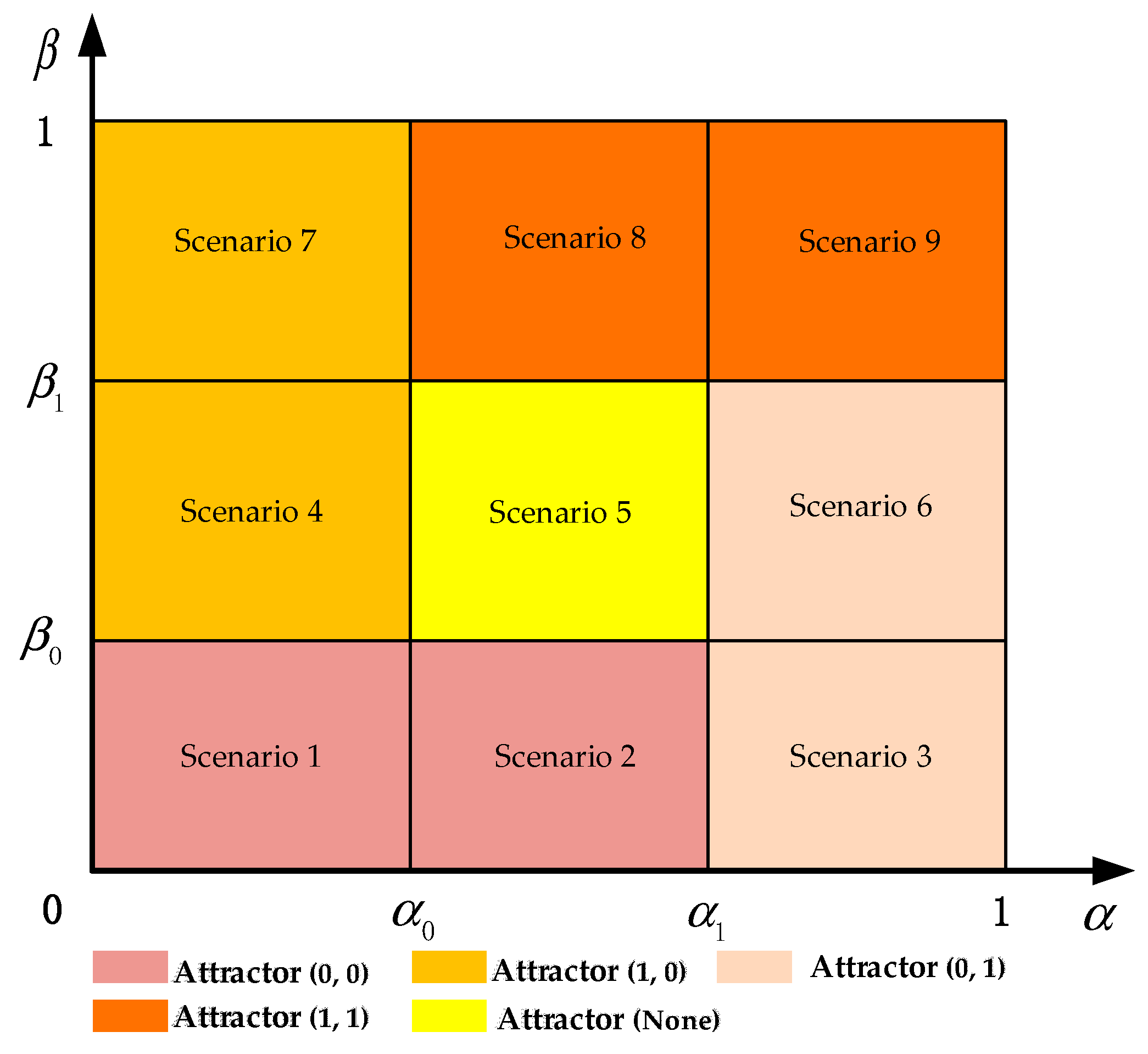

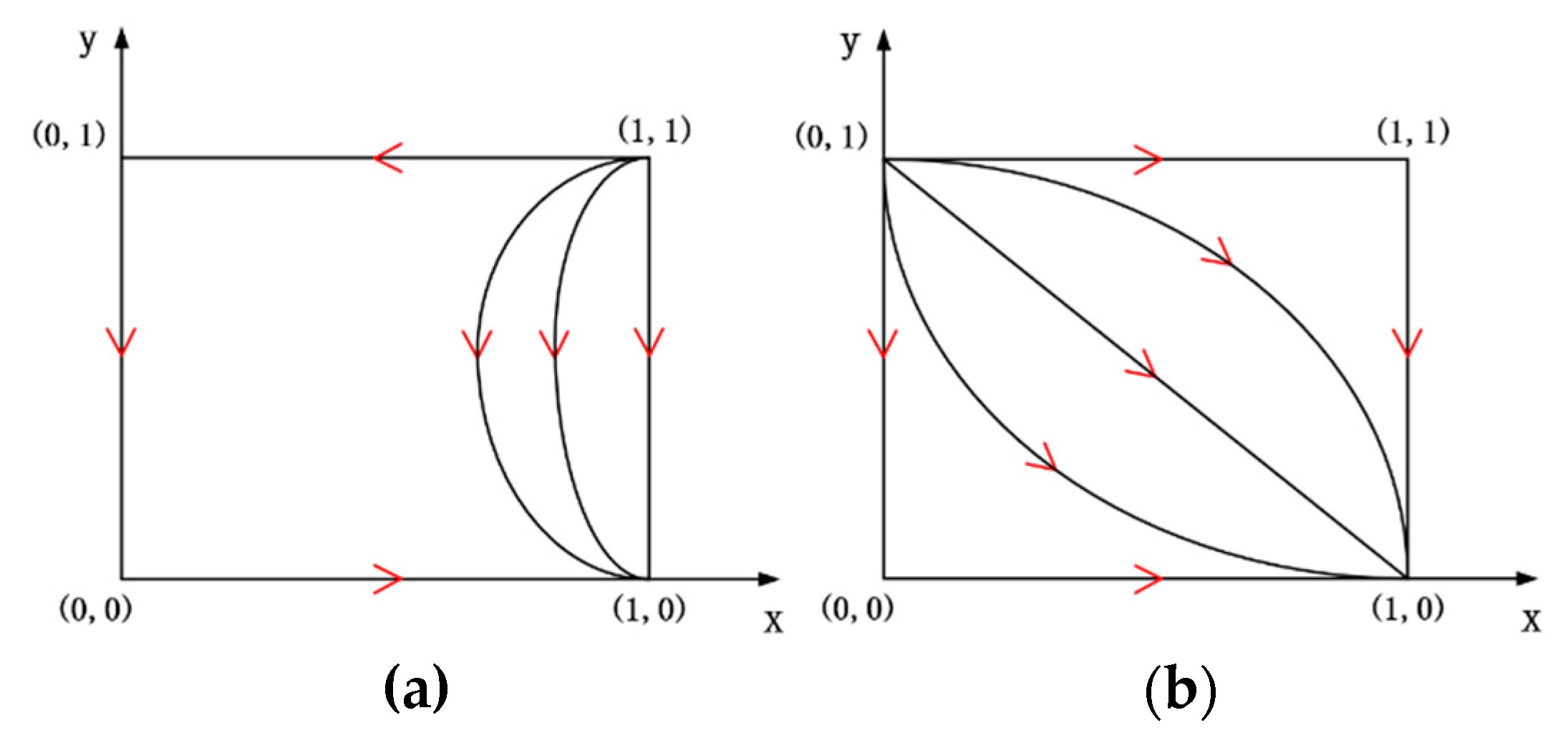
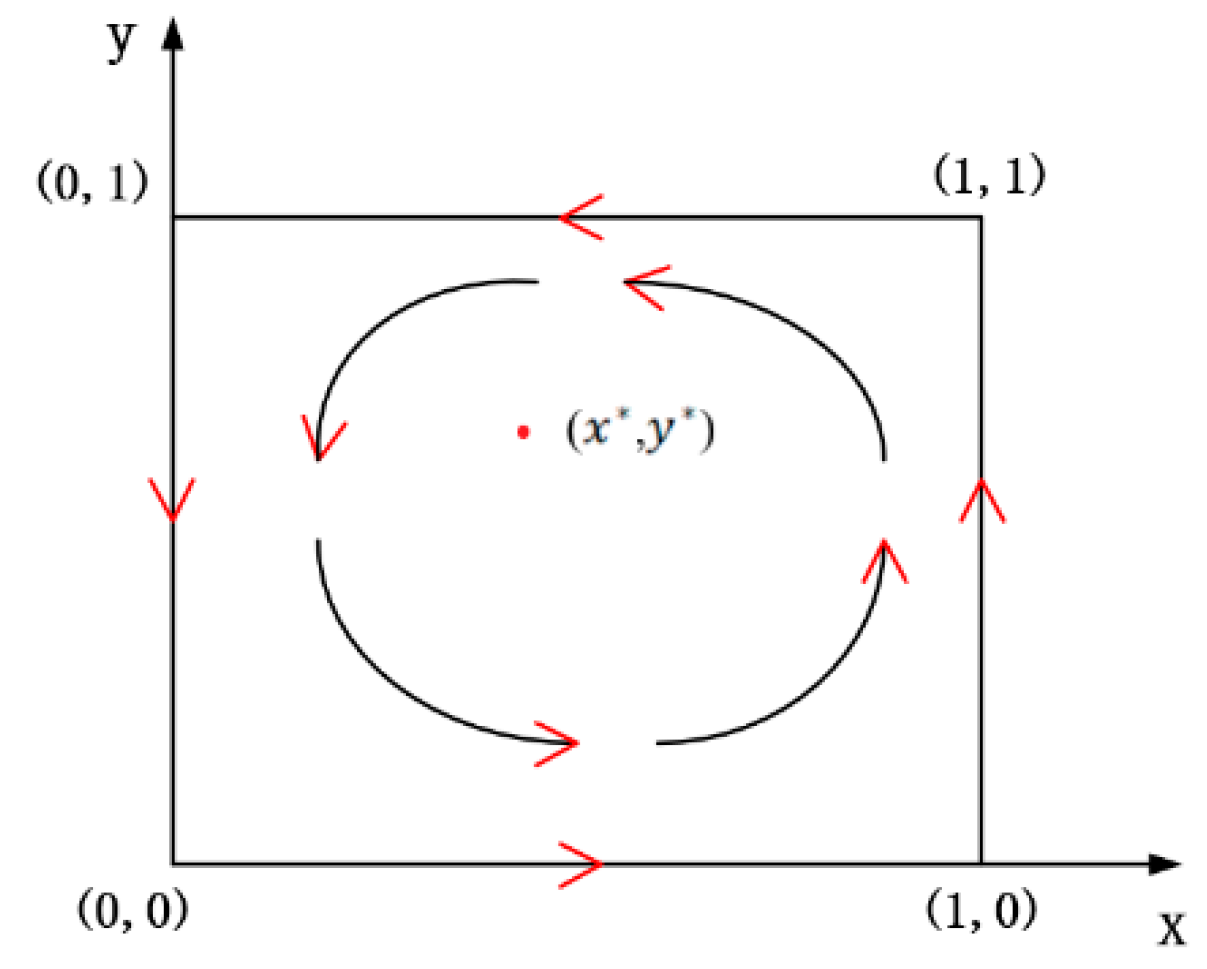
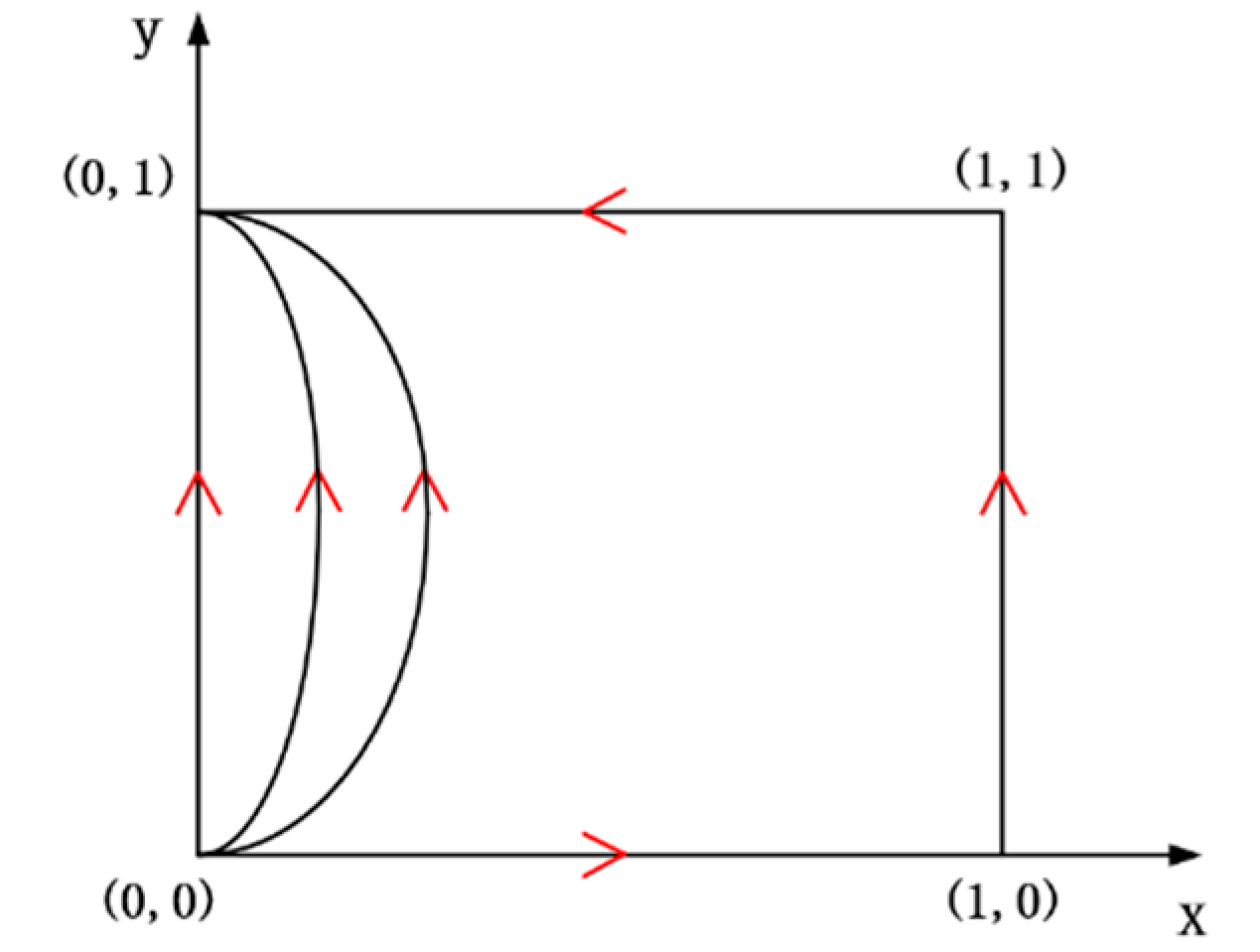
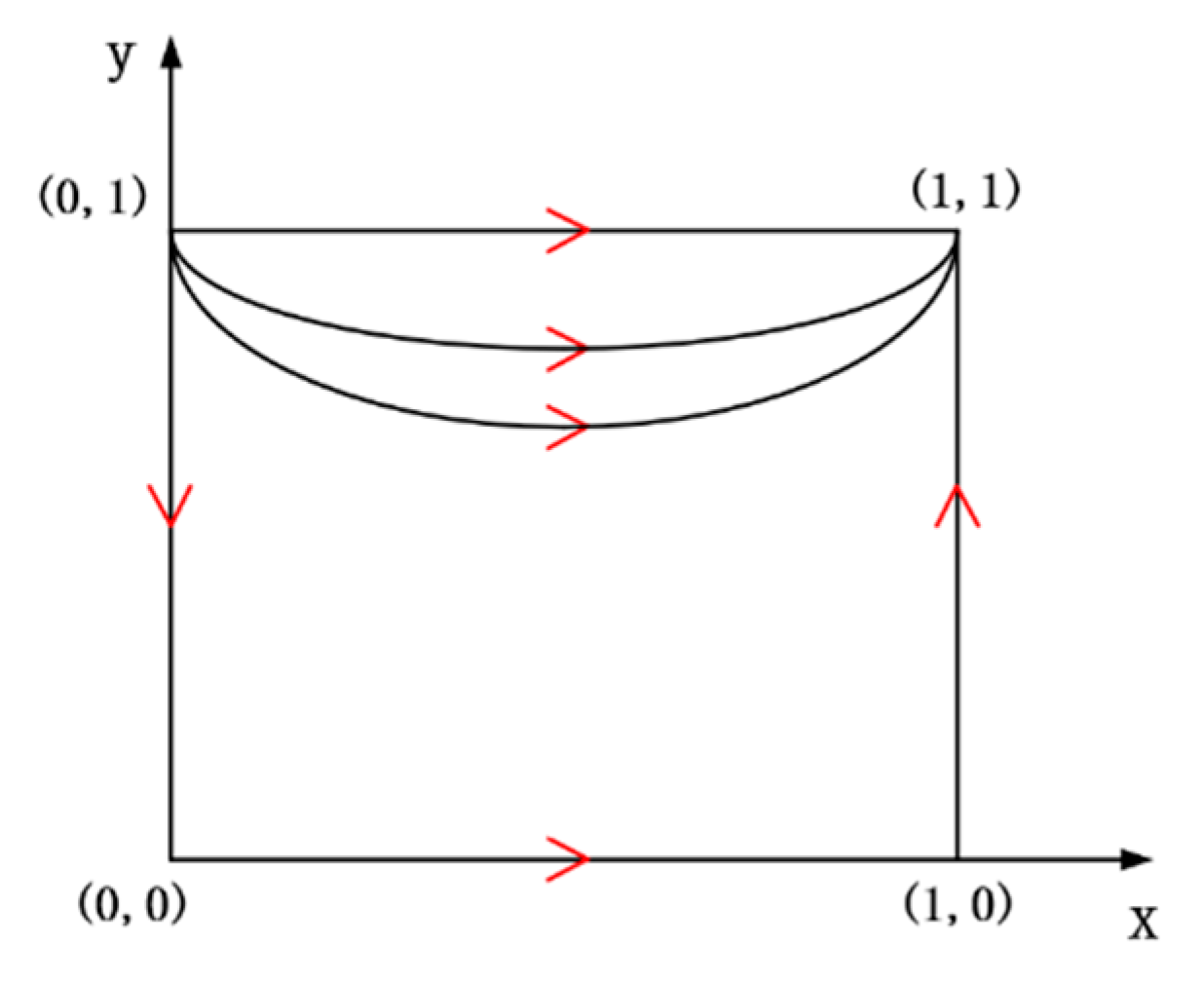
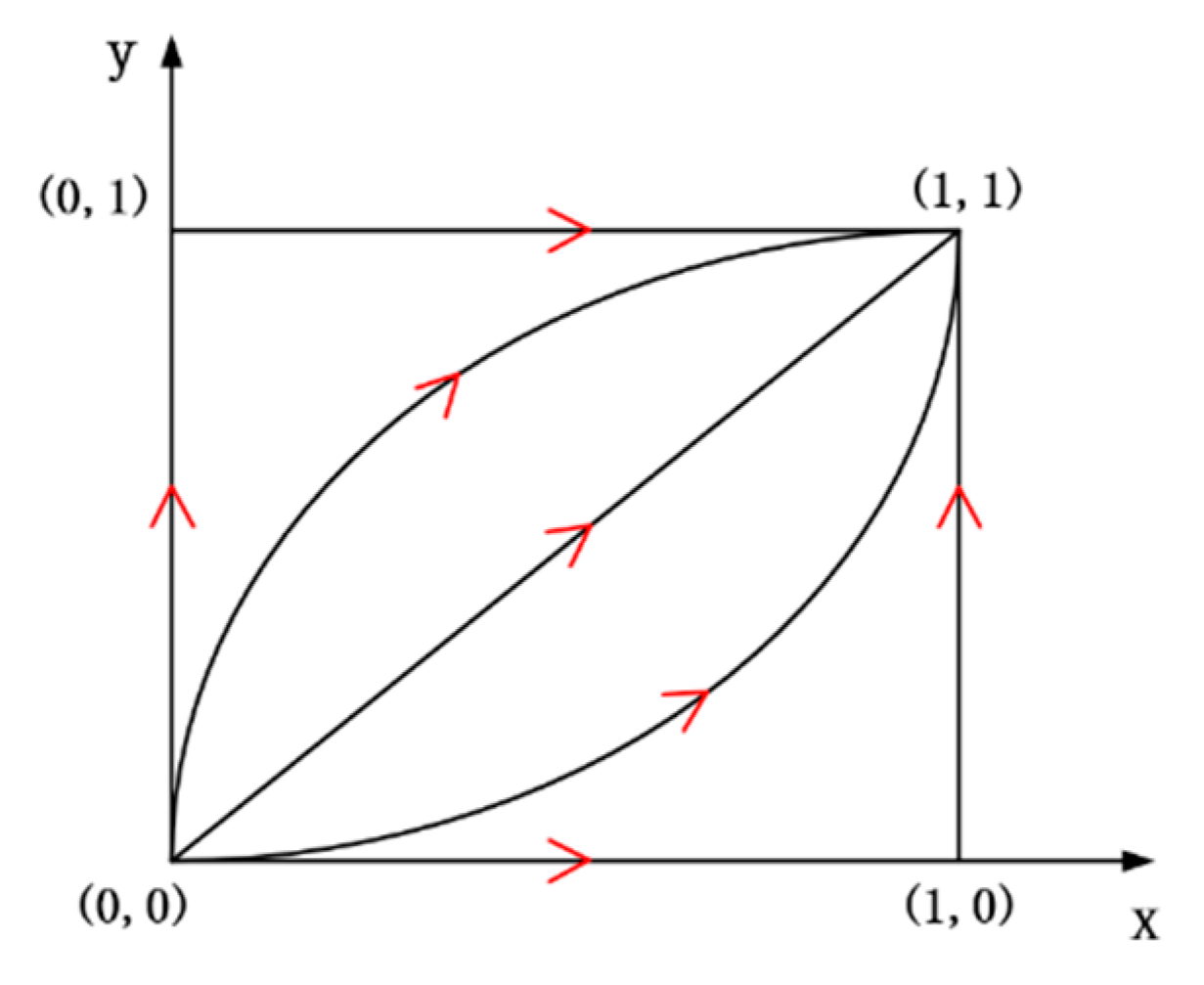

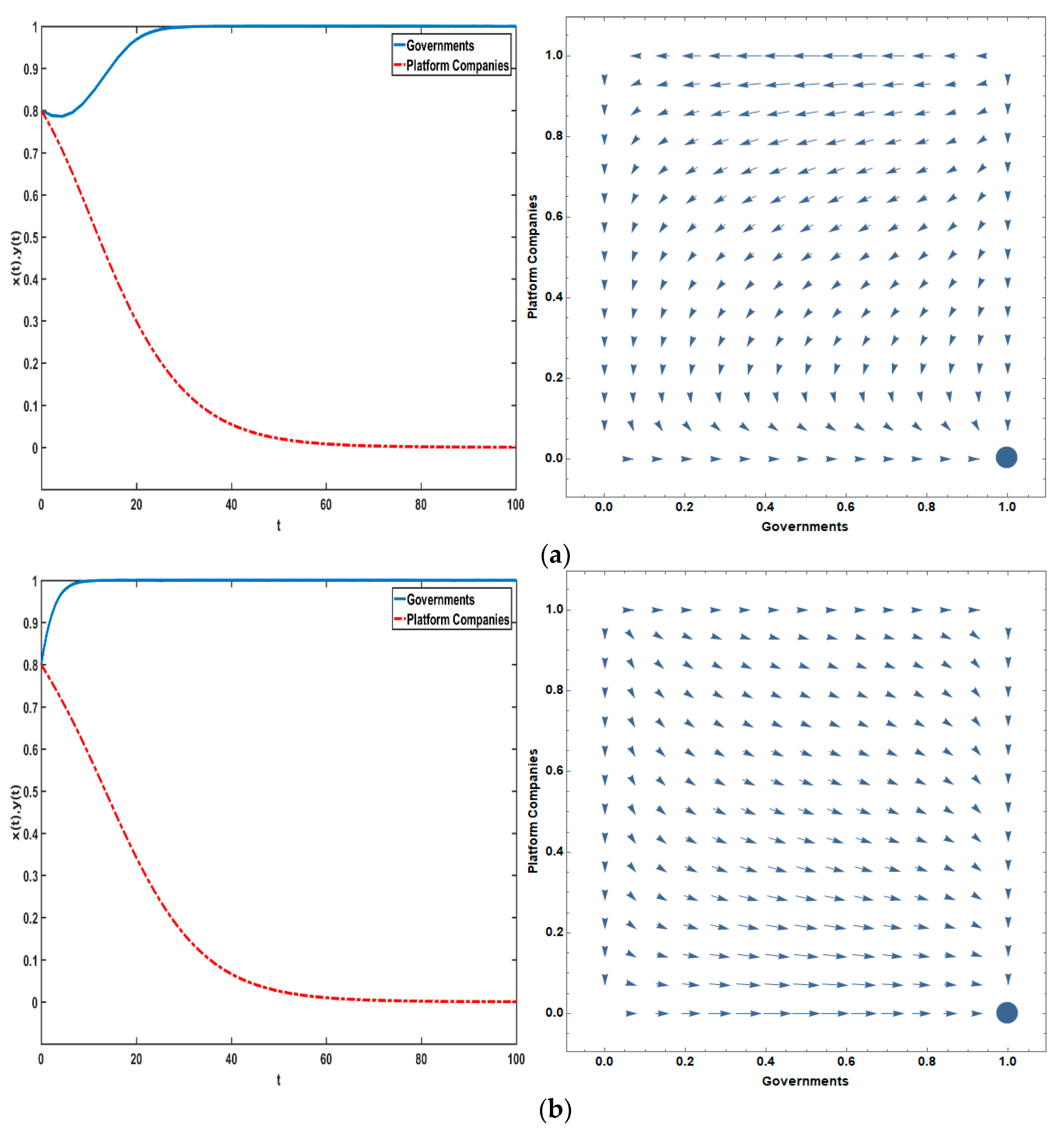

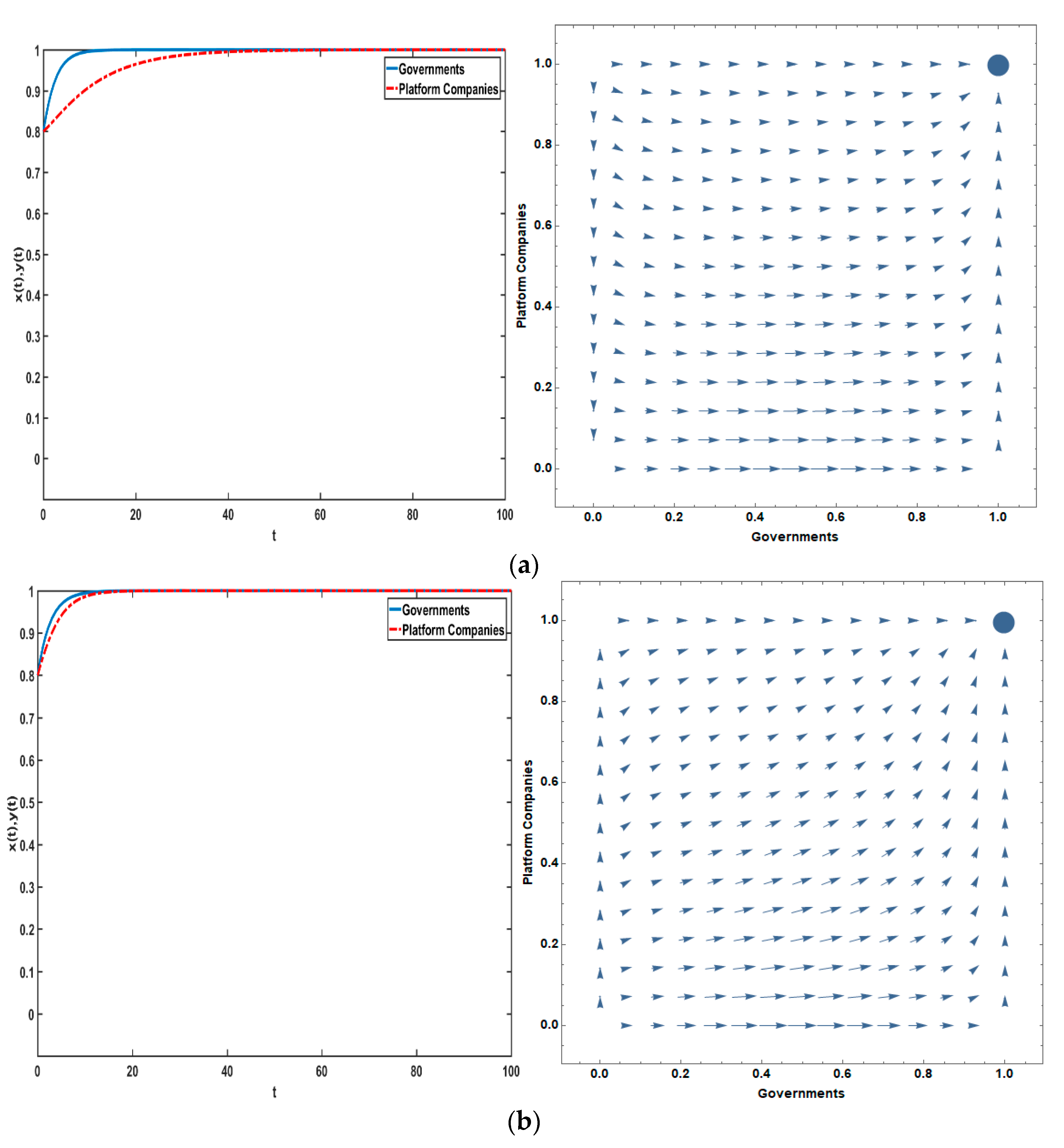
| () | () | |
| () | () |
| Notations | Descriptions |
|---|---|
| The IP of social media, where . It represents the influence and extent of social media on safety hazard or incident reports of ridesharing passengers. represents the weakest level of IP, and represents the strongest level of IP. | |
| The PD of Social media, where . It indicates the probability of social media participation in safety regulation of ridesharing passengers. represents the lowest level of PD, and represents the highest level of PD. | |
| In the case of government deregulation, as a social regulatory force, social media could find and expose ridesharing passenger safety issues in safety regulation with probability, where . | |
| The revenues of platform companies from ridesharing business. R is greater than the security input cost, . | |
| The security cost of platform companies (including driving experience reviews, background checks, itinerary monitoring, and emergency management costs). | |
| The losses suffered by platform companies after being regulated by governments or being exposed by social media (including the economic and reputational loss), where . | |
| The revenues of governments from SR strategy (including the rewards from higher levels of governments and the improvement of social credibility). In this case, it is assuming that H is equal to L. | |
| The potential losses faced by governments adopting LR strategy after ridesharing passengers’ security issues were exposed by social media. | |
| The costs of governments to choose SR strategy, where . The marginal regulatory cost is marked as . | |
| The fixed regulatory costs of governments’ strict regulation. is less than or equal to | |
| The regulatory capacity of governments, where represent the lowest level of government regulation, and represent the highest level of government regulation. | |
| The social welfare benefits. When platform companies choose ESI strategy, the social welfare benefits are obtained by governments. | |
| The social welfare losses. When platform companies choose ISI strategy, the social welfare losses are paid by governments. |
| Equilibrium Points | ||
|---|---|---|
| (0,0) | ||
| (1,0) | ||
| (0,1) | ||
| (1,1) | ||
| (, ) | −AB 1 | 0 |
| Social Media Metrics | Range of Corresponding Parameters | Levels |
|---|---|---|
| Low | ||
| Medium | ||
| High | ||
| Low | ||
| Medium | ||
| High |
| Attractors | Scenario 1 | Scenario 2 | Scenario 3 | ||||||
| Results | Results | Results | |||||||
| (0,0) | + | - | Stable | + | - | Stable | - | Uncertain | Saddle |
| (1,0) | - | Uncertain | Saddle | - | + | Unstable | + | + | Unstable |
| (0,1) | - | Uncertain | Saddle | + | Uncertain | Saddle | + | - | Stable |
| (1,1) | + | + | Unstable | - | Uncertain | Saddle | - | Uncertain | Saddle |
| Attractors | Scenario 4 | Scenario 5 | Scenario 6 | ||||||
| Results | Results | Results | |||||||
| (0,0) | - | Uncertain | Saddle | - | Uncertain | Saddle | + | + | Unstable |
| (1,0) | + | - | Stable | - | Uncertain | Saddle | - | Uncertain | Saddle |
| (0,1) | - | Uncertain | Saddle | - | Uncertain | Saddle | + | - | Stable |
| (1,1) | + | + | Unstable | - | Uncertain | Saddle | - | Uncertain | Saddle |
| Attractors | Scenario 7 | Scenario 8 | Scenario 9 | ||||||
| Results | Results | Results | |||||||
| (0,0) | - | Uncertain | Saddle | - | Uncertain | Saddle | + | + | Unstable |
| (1,0) | + | - | Stable | - | Uncertain | Saddle | - | Uncertain | Saddle |
| (0,1) | + | + | Unstable | + | + | Unstable | - | Uncertain | Saddle |
| (1,1) | - | Uncertain | Saddle | + | - | Stable | + | - | Stable |
| Scenarios | Social Media | Attractors | |
|---|---|---|---|
| IP | PD | ||
| Scenario 1 | Low | Low | (0,0) |
| Scenario 2 | Medium | (0,0) | |
| Scenario 3 | High | (0,1) | |
| Scenario 4 | Low | Medium | (1,0) |
| Scenario 5 | Medium | None | |
| Scenario 6 | High | (0,1) | |
| Scenario 7 | Low | High | (1,0) |
| Scenario 8 | Medium | (1,1) | |
| Scenario 9 | High | (1,1) | |
© 2020 by the authors. Licensee MDPI, Basel, Switzerland. This article is an open access article distributed under the terms and conditions of the Creative Commons Attribution (CC BY) license (http://creativecommons.org/licenses/by/4.0/).
Share and Cite
Sun, Q.; Li, T.; Ma, F.; Guo, X.; Wang, S. Dynamic Evolution of Safety Regulation of the Ridesharing Industry under Social Media Participation. Symmetry 2020, 12, 560. https://doi.org/10.3390/sym12040560
Sun Q, Li T, Ma F, Guo X, Wang S. Dynamic Evolution of Safety Regulation of the Ridesharing Industry under Social Media Participation. Symmetry. 2020; 12(4):560. https://doi.org/10.3390/sym12040560
Chicago/Turabian StyleSun, Qipeng, Tingzhen Li, Fei Ma, Xiaozhuang Guo, and Sijie Wang. 2020. "Dynamic Evolution of Safety Regulation of the Ridesharing Industry under Social Media Participation" Symmetry 12, no. 4: 560. https://doi.org/10.3390/sym12040560




